Galeni sexta classis eam chirurgie partem amplectitur…2nd Edition. Venice: Lucantonio and Tommaso Giunta, 1550.
 Born in Pergamum, a great cultural center in Asia Minor, Galen began his medical studies at an early age in his home city, and then traveled to Smyrna, Corinth and Alexandria for twelve years of additional education. His first position was in Pergamum as physician to the gladiators, but he later practiced in Rome, where he became physician to Emperor Marcus Aurelius. Galen was the most skilled physician of his time and remains, with regard to classical medicine, second only to Hippocrates in significance. His prolific writings were translated into Latin, Syriac and Arabic, and greatly influenced the medicine of these cultures. In medieval times, his writings were followed religiously, and his authority was not questioned until the Renaissance, though many physicians abided by the Galenic doctrine for centuries later.
Born in Pergamum, a great cultural center in Asia Minor, Galen began his medical studies at an early age in his home city, and then traveled to Smyrna, Corinth and Alexandria for twelve years of additional education. His first position was in Pergamum as physician to the gladiators, but he later practiced in Rome, where he became physician to Emperor Marcus Aurelius. Galen was the most skilled physician of his time and remains, with regard to classical medicine, second only to Hippocrates in significance. His prolific writings were translated into Latin, Syriac and Arabic, and greatly influenced the medicine of these cultures. In medieval times, his writings were followed religiously, and his authority was not questioned until the Renaissance, though many physicians abided by the Galenic doctrine for centuries later.
Philosophically speaking, Galen strove to fit everything into a theoretical framework, or to provide explanations and causes for everything in nature. This type of dogmatism and teleology contributed much to his popularity in the Middle Ages, but it also affected the accuracy of his work. His anatomy was further flawed because he was unable to use human cadavers due to the opinions of the time. Instead, he used animals, especially the Barbary ape, a homological imposition that demonstrably affected his assertions concerning human anatomy. Nevertheless, his anatomy remained unquestioned until the great sixteenth century anatomist, Andreas Vesalius. He also founded the practice of experimental physiology and neurology, with which he made some major discoveries about the nervous, respiratory, and circulatory systems that remained the only real physiological knowledge until the seventeenth century (Garrison 115-116).
One famous early Latin translation of Galen’s complete works was done by the Giunta family of Venice. The translation was a great financial success, and the Giuntas ended up creating nine editions between 1541 and 1625. One claim to fame for this translation is that Vesalius actually worked on the sections dealing with anatomical procedures. The Reynolds-Finley Library owns the Giunta’s second edition from 1550 on surgical procedures, Galeni sexta classis eam chirurgie partem amplectitur.
Clendening, Source Book of Med. Hist., p. 41; Dict. Sci. Bio. Vol. 5-6, pp. 228-230; Garrison, Hist. Med.,4th Edition, pp. 112-117; Garrison & Morton, Med. Bib., 5th Edition, 27; Heirs of Hippocrates, 18; Reynolds Historical Library, Rare books and coll…, 1586.
Image: Woodcut, Galeni sexta classis eam chirurgie partem amplectitur (1550), Reynolds-Finley Historical Library.
